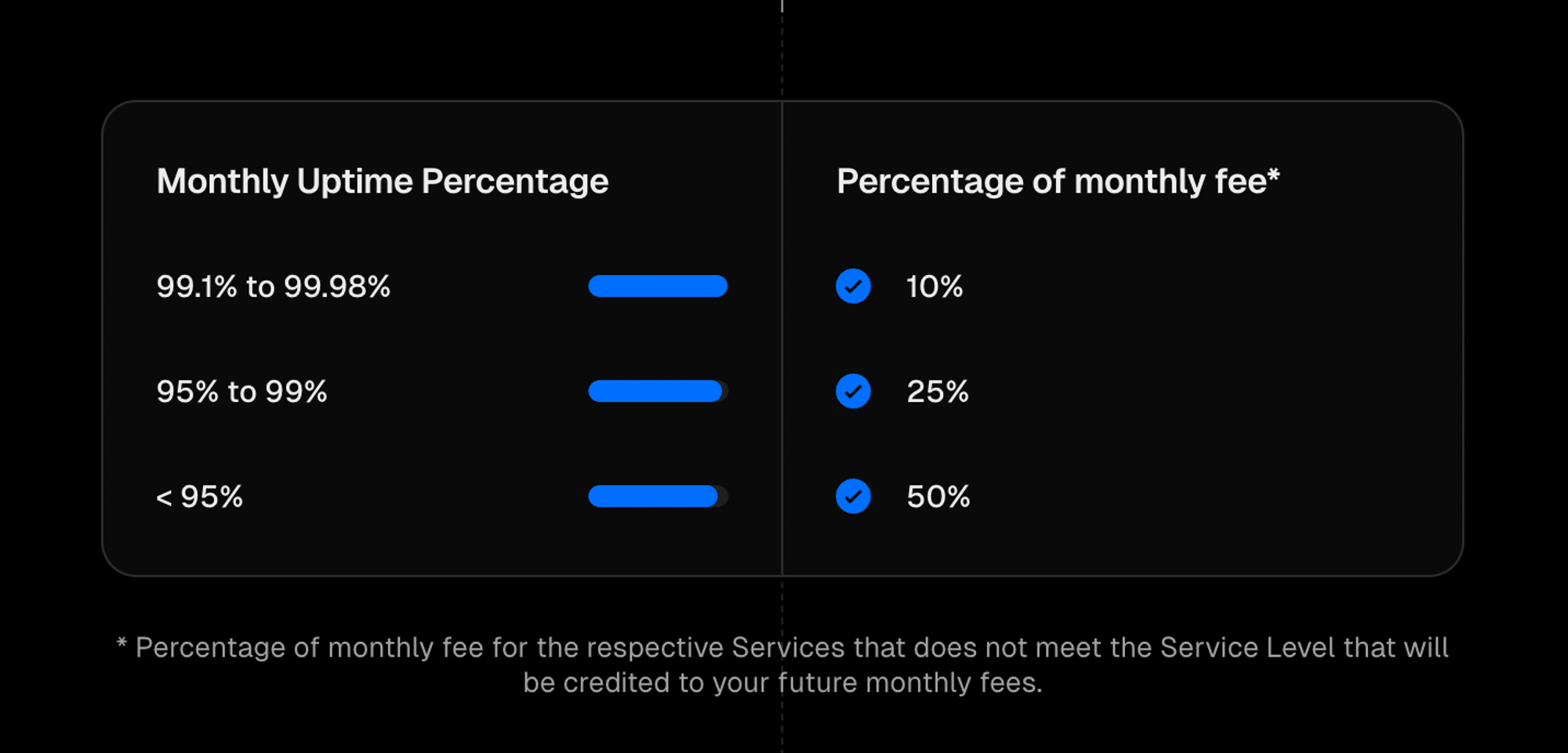In today's fast-paced digital landscape, businesses rely heavily on technology to deliver seamless customer experiences. This makes the reliability, availability, and performance of IT services more critical than ever. To ensure that these services meet the expected standards, organizations use Service Level Agreements (SLAs), But what exactly are SLAs and why are they so important?
A Service Level Agreement (SLA) is a contractual document between a service vendor and a customer that defines the expected level of service from the provider. It includes the metrics used to measure the service, the remedies or penalties if the service does not meet expectations, and the responsibilities of both the vendor and the customer.
Take the example of Vercel's SLA, which guarantees 99.99% uptime. This translates to approximately 8.6 seconds of downtime per day or 52 minutes and 9.8 seconds per year. If Vercel fails to meet this SLA, they offer credits to customers.

A credit is a specified percentage of the monthly service fees applied if there is an unscheduled downtime that breaches the agreed-upon service level agreement (SLA).
Importance of SLA
Service Level Agreements (SLAs) are crucial for several reasons, particularly in the context of business and IT services. Here are some key points highlighting the importance of SLAs:
- Clear Expectations: SLAs define the expected level of service, including performance metrics, responsibilities, and deliverables. This clarity helps prevent misunderstandings and sets a clear benchmark for both parties.
- Accountability: By establishing specific criteria for performance, SLAs hold service providers accountable for their performance. This accountability ensures that service providers meet their commitments, which helps maintain trust between the parties involved.
- Improved Relationships: By fostering transparency and trust, SLAs can strengthen the relationship between service providers and their customers.
- Strategic Alignment: SLAs help align the services provided with the business goals and objectives of the customer. This alignment ensures that the service provider’s efforts contribute directly to the customer’s success.
How to setup right SLA ?
Setting up an SLA for a service depends on the specific business, as each business has a unique SLA contract. the measurement of metric also various for each business services.
Define Service :
It Provides a detailed explanation of the services to be provided by the vendor. This includes a brief description of what the service is, its purpose and availability of service. The Service Description is essential for setting clear expectations and ensuring both parties have a mutual understanding of the service being provided. This helps set clear expectations, minimize misunderstandings, and make sure that both the service provider and client agree on what will be delivered.
Identify Stakeholders
When defining SLA, it's important to identify all stakeholders involved. as these are the individuals and groups directly affected by the agreement. Stakeholders can include customers, end-users, internal teams, and even third-party vendors. Understanding who these stakeholders are helps in tailoring the SLA to meet their specific needs and expectations. For an example, customers may prioritize uptime and fast issue resolution, while internal teams might focus on clearly defined responsibilities and workflows. By identifying and considering all stakeholders, you can ensure that the SLA is comprehensive and aligned with the goals and expectations of everyone involved, leading to better service delivery and satisfaction.
Establish Metrics
While creating a SLA, it's important to mention the performance metric of the service to evaluate the service. These metrics should be carefully selected to accurately reflect the quality and efficiency of the service. Some of the metrics are given below,
- Response Time: This metrics use to measure the time taken to response to customer or end user when issue or request reported.
- Resolution Rate: Resolution Rate refers to the time taken to resolve a reported issue.
- Uptime : This is use to tracks availability of services which provide vendor, Uptime metric is defined in percentage format eg: 99.9% or 99.99%
Set Targets
When setting targets within an SLA, it's important to achieve goals for each performance metric. These targets should be based on a careful review of historical data to understand past performance levels. also it important to consider the availability of resource , resources such as, , technology, employees and budget. The targets should match the company's overall goals, helping to achieve the main objectives while being practical and achievable
Define Consequences
it’s essential to clearly specify the consequences for not meeting the established targets. These consequences may include penalties for underperformance, bonuses for exceeding expectations, and detailed escalation procedures to address issues that arise when targets are not met.
Monitor and Review
It's important to continuously monitor and review service performance to ensure that targets are being met. Regular evaluations allow for adjustments to the SLA when necessary, ensuring that it remains effective and aligned with the current needs of the business.
Best practices for setting up an effective SLA
Setting up an effective Service Level Agreement (SLA) is crucial for ensuring clear expectations and a strong partnership between a service provider and a client. By following best practices you can create good SLA
Define a separate SLA for each service:
You must define a separate SLA contract for each service. Since every service serves a unique purpose, each one faces distinct challenges. Some issues can be resolved quickly, while others may take a day or even a few weeks.
Track SLA performance
You shouldn't depend involved on the vendor for reports on SLA performance. It's important to measure the performance from your side as well. This ensures that both parties have a clear understanding and a shared source of truth for the relevant metrics.
Set realistic targets
Understand your current and future business needs, and use that information to define key metrics. Set targets for both minimum and maximum requirements for each metric.
Regular communication and reporting
Effective communication and reporting between the vendor and customer are essential for maintaining transparency, trust, and feedback. Customers can help identify and address gaps in service delivery. Communication and reporting can occur through various channels, including emails, phone calls, and meetings.
Review and update
Monitoring an SLA is to review and update the SLA periodically Reviewing and updating the SLA periodically allows both parties to evaluate the performance and satisfaction of the service delivery, as well as to identify and implement any improvements or adjustments, also help to avoid or minimize conflicts or disputes.
Use Internal SLA
In additional customer focusing SLA. it's also advisable to use internal metrics that manage interdepartmental communication.
Conclusion
A Service Level Agreement (SLA) is a valuable tool for ensuring that your organization delivers high-quality services that fulfill your customers' needs. An effective SLA is not a static document but a dynamic agreement that adapts to your organization's evolving needs. Regularly review and update your SLA to ensure it stays relevant, effective, and aligned with your business objectives.

